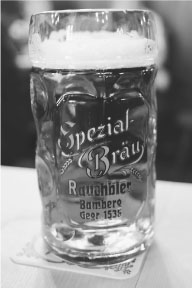Rauchbier is a German-style beer brewed with smoked malt. It can be any style, but most commonly it is a medium-strength lager. Rauchbier (German for “smoke beer”) is quite popular in Franconia, especially in Bamberg and its surroundings, where it is usually brewed to märzen strength. Aecht Schlenkerla Rauchbier from Brauerei Heller-Trum is probably the best known brand. Schlenkerla’s historic brewery tap is only 100 m from the Romanesque cathedral of Bamberg, so many tourists make their way over for a beer and some food. The tourists are told quite a tale—that rauchbier originated in a cloister that had been caught on fire, as happened often in medieval cities. As the legend goes, much of the cloister was destroyed, but part of the brewhouse, including a good amount of malt, had been spared. The malt, however, had been exposed to the smoke from the nearby fire and picked up this special flavor, which made the beer famous.

Rauchbier, beer brewed with smoked malt, is a favorite beer style in Bamberg, Germany. cath harries
This tale may be full of action and dramatic flames, but it is most unlikely that it has any historic validity. Some smokiness must have been typical for most kilned malts before new malting and kilning technologies were invented in the early 19th century: Combustion gases from the heat chamber would pass through to the kiln’s perforated floor and add flavor to the malt. Today this effect is desired only in specific smoked lagers, weizenbiers, bockbiers, and porters—and the malt used for this purpose is produced separately in a kiln where smoke from cured beechwood (for some rare malts it may also be oak) is used to dry the malt.
During the brewing process, the amount of smoked malt in the mash is crucial for the desired smokiness—as is the yeast. Some modern brewers have noticed that their first rauchbier does not taste as smoky as they would like—even when it is brewed from 100% smoked malt. This is because the yeast absorbs a significant portion of the smoky flavor during fermentation. If this “smoked” yeast is subsequently used to ferment a nonsmoked beer, it too may show a hint of smokiness. Schlenkerla uses this fact for good effect in its Helles lager, a brew made without smoked malt, but with repitched rauchbier yeast. More typically, rauchbier yeast is repitched into consecutive rauchbier batches for a consistent smokiness. This yeast trick even works with brews that are not made from 100% smoked malt, that is, when part of the mash is made up of caramel and dark malts for extra body and mouthfeel.
A strong smokiness is especially desirable when rauchbier is paired with food. Typical Franconian pairings often involved smoked meats, which are a local specialty. In general, most any hearty food, German or otherwise, tends to work well with the smoky rauchbier flavors—rauchbier itself is often described as smelling like campfires, bacon, or sausages. Not surprisingly, many cigar aficionados, perhaps enjoying the greatest concentration of smoke flavors they can get, have enjoyed rauchbiers with their favorite cigars.
In recent years brewers have brewed a broader spectrum of smoked beers: a seasonal rauchbock has been brewed for some time in Franconia and American brewers have turned smoked porter into a respected and well-loved beer style. Smoked wheat beers have appeared during the past decade as well. Smoked wheat ales (aka rauchweizen) are brewed from approximately 60% conventional wheat malt and 40% smoked barley malt. They are fermented with a traditional strain of Bavarian Hefeweizen yeast. Because of the smaller amount of smoked malt in the grist and the use of a yeast that produces its own balancing aromas, rauchweizen has become the beer of choice for those who can enjoy some smoked flavor but don’t want the intensity of classical rauchbier. Smoked beers generally age well, with the smoky characteristics melding with sherryish notes as the beer slowly oxidizes.
